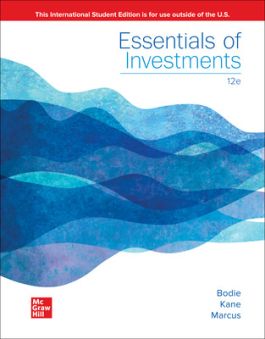Essentials of Investments ISE
Part ONE: ELEMENTS OF INVESTMENTS?
Chapter 1: Investments: Background and Issues
Chapter 2: Asset Classes and Financial Instruments
Chapter 3: Securities Markets?
Chapter 4: Mutual Funds and Other Investment Companies?
Part TWO: PORTFOLIO THEORY?
Chapter 5: Risk, Return, and the Historical Record?
Chapter 6: Efficient Diversification?
Chapter 7: Capital Asset Pricing and Arbitrage PricingTheory?
Chapter 8: The Efficient Market Hypothesis?
Chapter 9: Behavioral Finance and Technical Analysis?
Part THREE: DEBT SECURITIES?
Chapter 10: Bond Prices and Yields?
Chapter 11: Managing Bond Portfolios?
Part FOUR: SECURITY ANALYSIS?
Chapter 12: Macroeconomic and Industry Analysis?
Chapter 13: Equity Valuation?
Chapter 14: Financial Statement Analysis?
Part FIVE: DERIVATIVE MARKETS?
Chapter 15: Options Markets?
Chapter 16: Option Valuation?
Chapter 17: Futures Markets and Risk Management?
Part SIX: ACTIVE INVESTMENT MANAGEMENT?
Chapter 18: Evaluating Investment Performance?
Chapter 19: International Diversification?
Chapter 20: Hedge Funds?
Chapter 21: Taxes, Inflation, and Investment Strategy?
Chapter 22: Investors and the Investment Process?
Appendixes
A References
B References to CFA Questions?
Index?
The market-leading undergraduate investments textbook, Essentials of Investments by Bodie, Kane, and Marcus, continues to evolve along with the changes in the financial markets yet remains organized around one basic theme—that security markets are nearly efficient, meaning that you should expect to find few obvious bargains in these markets.
This text places great emphasis on asset allocation while presenting the practical applications of investment theory. The text also focuses on investment analysis, which allows us to present the practical applications of investment theory and convey practical value insights. A collection of Excel spreadsheets is provided to give you the tools to explore concepts more deeply.
In their efforts to link theory to practice, the author team also makes their approach consistent with that of the CFA Institute. Included are questions from previous CFA exams in our end-of-chapter problems and CFA-style questions derived from the Kaplan-Schweser CFA preparation courses.

